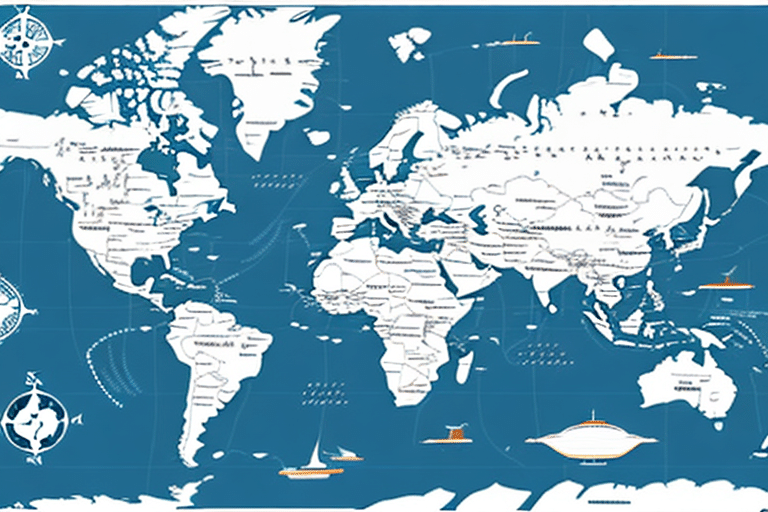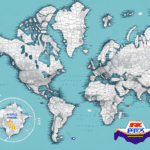Creating Batch Export Maps with UPS WorldShip: A Step-by-Step Guide to Locating Your Destination
Successfully shipping large volumes of packages to multiple destinations is a complex task that requires careful planning and execution. UPS WorldShip is a comprehensive shipping solution that offers a variety of tools to help businesses streamline their shipping processes and manage large volumes of shipments efficiently.
Understanding the Need for Batch Export Maps in UPS WorldShip
One of the key features of UPS WorldShip is its Batch Export Mapping functionality. This feature allows businesses to create custom shipping maps that can be used to quickly and accurately select shipping destinations for multiple packages in a single batch operation.
The need for Batch Export Mapping arises when businesses have to ship large volumes of packages to multiple destinations. This can be a time-consuming and error-prone process if done manually. With Batch Export Mapping, businesses can save time, reduce errors, and streamline their shipping operations.
Batch Export Mapping also allows businesses to easily track and manage their shipments. By creating custom maps, businesses can assign specific carriers, services, and package types to each destination. This ensures that each package is shipped using the most efficient and cost-effective method possible.
How to Set Up Batch Export Maps in UPS WorldShip
The first step in setting up Batch Export Maps in UPS WorldShip is to create a new map. This can be done by selecting the "New Map" option from the Batch Export Mapping menu.
Once you've created a new map, the next step is to define the map settings. This includes selecting the destination countries, regions, and postal codes. You can also specify shipping methods, package types, and other parameters that are relevant to your business.
After defining the map settings, save the map and use it to quickly and accurately select shipping destinations for multiple packages in a single batch operation.
It's important to note that Batch Export Maps can also be customized to include specific product information, such as weight, dimensions, and value. This helps ensure that your shipments comply with international regulations and avoid any delays or additional fees.
Additionally, UPS WorldShip allows you to schedule automatic batch exports, which can save you time and streamline your shipping process. By setting up a recurring export, you can ensure that your shipments are processed and delivered on time, without the need for manual intervention.
Step-by-Step Guide to Locating Your Destination with UPS WorldShip
- Select the "Batch Export Mapping" option from the WorldShip menu.
- Choose the map you want to use from the Maps list.
- Enter the necessary information, such as the destination address and shipping method, for each package in the batch operation.
UPS WorldShip will automatically calculate the shipping cost and generate shipping labels for each package in the batch operation. This process can be easily tracked and managed using the UPS WorldShip interface.
Additionally, UPS WorldShip allows you to save frequently used destinations for quick access in the future, saving time and streamlining the shipping process for businesses that frequently ship to the same locations.
UPS WorldShip also offers a variety of customization options for shipping labels, including the ability to add logos and custom text. This helps businesses create a professional and branded appearance for their shipping labels.
Defining and Managing Your Batch Export Map Settings
To define and manage your Batch Export Map settings in UPS WorldShip:
- Select the "Batch Export Mapping" option from the WorldShip menu.
- Choose the map you want to edit from the Maps list.
- In the Map Settings dialog box, specify the destinations, shipping methods, package types, and other relevant parameters.
Ensure that the information provided is accurate and up-to-date to avoid any potential errors or delays in the shipping process.
If managing multiple maps, create folders to organize them for easier access. Simply right-click on the Maps list, select "New Folder," name the folder, and drag and drop maps into it.
Tips to Ensure Accuracy in Your Batch Export Maps with UPS WorldShip
- Define Map Settings Carefully: Select the correct destination countries, regions, and postal codes, and specify accurate shipping methods and package types.
- Use the Latest Version: Ensure you're using the most recent version of UPS WorldShip for optimal performance and access to the latest features.
- Double-Check Package Details: Verify the weight and dimensions of your packages to ensure accurate shipping rates and timely deliveries.
- Validate Shipment Information: Confirm the accuracy of recipient addresses and contact information to prevent delivery issues.
For more detailed best practices, refer to the UPS WorldShip User Guide.
Customizing Your Batch Export Maps for Different Shipping Needs
UPS WorldShip allows businesses to customize their Batch Export Maps based on specific shipping needs. This includes:
- Specifying different shipping methods and package types for different maps.
- Defining custom parameters relevant to your business, such as order numbers or product codes.
By customizing your Batch Export Maps, you can:
- Streamline Shipping Operations: Pre-define shipping methods and package types to eliminate manual selections for each shipment.
- Reduce Errors: Minimize the risk of human error by automating selections based on predefined criteria.
- Enhance Data Tracking: Track and analyze shipping data more effectively to identify areas for improvement and optimize operations.
For industry-specific customization options, consult the UPS Technology Integration Services.
The Importance of Data Validation in Batch Export Maps with UPS WorldShip
Data validation is crucial for creating accurate and reliable Batch Export Maps with UPS WorldShip. It ensures that data entered, such as destination addresses and package details, is correct and up-to-date.
UPS WorldShip employs various tools and algorithms to check for errors and inconsistencies in your data, helping ensure that packages are delivered promptly and accurately.
Without proper data validation, packages may be delayed or lost in transit, leading to dissatisfied customers and potential revenue loss. Taking the time to validate your data before creating Batch Export Maps can help avoid these issues and maintain high shipping standards.
For more information on data validation best practices, refer to the UPS Technology Support.
Common Issues and Troubleshooting Tips for Creating Batch Export Maps with UPS WorldShip
Businesses may encounter several issues when creating Batch Export Maps with UPS WorldShip, including:
- Data entry errors
- Incorrect destination addresses
- System errors
- Connectivity issues
Troubleshooting Tips:
- Check Your Data: Carefully review all entered data for accuracy.
- Validate Map Settings: Ensure that all map settings are correctly configured.
- Update UPS WorldShip: Make sure you are using the latest version of the software.
- Contact Support: If issues persist, reach out to UPS Customer Support.
- Address Connectivity Issues: Check your internet connection and UPS server status. Consider using UPS WorldShip Connect for offline processing and batch shipping.
Best Practices for Creating and Managing Batch Export Maps with UPS WorldShip
To maximize the efficiency and accuracy of your Batch Export Maps with UPS WorldShip, follow these best practices:
- Define Map Settings Carefully: Accurately set destination countries, shipping methods, and package types.
- Validate Your Data: Ensure all shipment data is correct before processing.
- Customize Maps: Tailor maps to your specific shipping needs for improved efficiency.
- Use the Latest Software Version: Keep UPS WorldShip updated to access the latest features and security updates.
- Regularly Review and Update Maps: Adjust map settings as your shipping needs evolve.
- Train Your Staff: Provide training sessions or user manuals to ensure your team can effectively use UPS WorldShip and Batch Export Maps.
For comprehensive best practices, refer to the UPS Shipping Services Guide.
The Benefits of Using UPS WorldShip for Batch Export Maps
Using UPS WorldShip for Batch Export Maps offers numerous benefits, including:
- Increased Efficiency: Automate and streamline the shipping process for large volumes of packages.
- Reduced Errors: Minimize manual entry mistakes with automated mapping and validation.
- Cost Savings: Optimize shipping methods and package types to reduce costs.
- Improved Tracking: Easily track and manage multiple shipments within a single interface.
- Enhanced Customer Satisfaction: Ensure timely and accurate deliveries, meeting customer expectations.
For more on the benefits, visit the UPS Software Solutions page.
Comparing UPS WorldShip's Batch Export Mapping Functionality to Other Shipping Solutions
UPS WorldShip offers a robust Batch Export Mapping functionality that stands out in the industry. When compared to other shipping solutions, UPS WorldShip provides:
- User-Friendly Interface: An intuitive design that simplifies the mapping process.
- Reliability: Proven performance and reliability for handling large volumes of shipments.
- Comprehensive Features: Advanced features such as automatic batch exports and customizable shipping labels.
- Integration Capabilities: Seamless integration with other business systems and software.
Other shipping solutions may offer similar features but often lack the same level of user-friendliness, reliability, and comprehensive functionality found in UPS WorldShip.
For a detailed comparison, refer to industry reports from sources like Gartner and Forrester.
Industry-Specific Use Cases for Creating Batch Export Maps with UPS WorldShip
Different industries have unique shipping requirements, and UPS WorldShip's Batch Export Maps can be tailored to meet these needs:
E-commerce
E-commerce businesses often handle a high volume of shipments to diverse locations. Batch Export Maps help streamline order fulfillment, ensuring timely and accurate deliveries.
Retail
Retailers can use Batch Export Maps to manage shipments to multiple store locations, optimizing inventory distribution and reducing shipping costs.
Manufacturing
Manufacturers can track shipments of raw materials and finished products, ensuring efficient supply chain management and timely deliveries to clients.
For more industry-specific solutions, explore the UPS Industries Page.
Future Developments and Enhancements in Batch Export Mapping with UPS WorldShip
UPS is continually enhancing its Batch Export Mapping functionality to better serve businesses and their evolving needs. Future developments may include:
- Improved Data Validation: Enhanced tools for more accurate data entry and validation.
- Greater Customizability: More options for customizing maps to fit specific business requirements.
- Expanded Functionality: Additional features tailored to specific industries and complex shipping needs.
- Advanced Analytics: Better data analysis tools for tracking shipping performance and identifying optimization opportunities.
Staying updated with the latest UPS WorldShip developments ensures that your business can leverage new features and enhancements as they become available.
For information on upcoming features, keep an eye on the UPS Training and Updates section.
Conclusion
Overall, UPS WorldShip's Batch Export Mapping functionality is a powerful tool for businesses that need to manage large volumes of shipments efficiently and accurately. By following best practices, carefully defining map settings, and validating your data, you can streamline your shipping operations and better meet the needs of your customers.
For more information and resources, visit the UPS Shipping Services website.






















